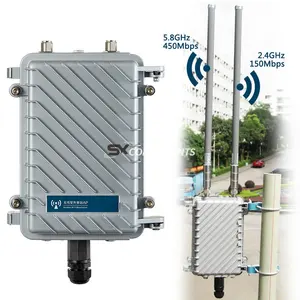A long-range router extends the reach of a Wi-Fi signal, providing a more expansive coverage area compared to traditional routers. Its primary function is to transmit data over longer distances, reducing dead zones and ensuring a stable connection throughout a home or office.
Types of Long-Range Routers and Comparisons
The first type of long-range router is the traditional long-range router designed with powerful antennas and advanced signal optimization technologies to provide extended coverage in large homes or offices. They typically operate on both 2.4GHz and 5GHz bands and may feature beamforming technology for targeted signal delivery. There is also the outdoor long-range router for those looking to extend connectivity beyond the confines of their homes. These rugged devices can withstand the elements, providing Wi-Fi coverage in outdoor spaces such as gardens, patios, or even large commercial areas.
There is also the gaming long-range router. Gaming routers with long-range capabilities prioritize low latency and high-speed connections, making them suitable for online gaming enthusiasts. They often feature advanced Quality of Service settings, multiple antennas, and MU-MIMO technology to ensure a stable gaming experience even at a distance. The wireless long-range router operates independently without the need for additional nodes. In a wireless long-range router vs mesh comparison, mesh networks are popular for their ability to cover large areas by using multiple interconnected devices. This makes it a simpler solution for those seeking extended coverage without the complexity of a mesh setup.
When comparing the long-range router vs WiFi extender, there are significant differences depending on the user's preferences. While both long-range routers and Wi-Fi extenders aim to enhance coverage, they operate differently. A long-range router extends coverage by design, eliminating the need for additional devices. In contrast, a Wi-Fi extender works by capturing an existing signal and rebroadcasting it, potentially leading to a loss in speed.
Benefits of a Long-Range Router
The most obvious benefit of a long-range router is the extended coverage it provides. Say goodbye to Wi-Fi dead zones and enjoy a seamless connection in every corner of the home. Also, long-range routers often come equipped with advanced technologies that mitigate interference from other electronic devices. This results in a more stable and reliable connection. With a long-range router, there is improved performance, especially when streaming high-definition content, engaging in online gaming, or conducting video conferences. The enhanced signal strength translates to faster data transfer rates. Investing in a long-range router can be a cost-effective alternative to setting up a mesh network, making it an attractive option for those looking to maximize coverage without breaking the bank.
Features of a Long-Range Router
Many long-range routers employ beamforming technology, which focuses the Wi-Fi signal directly to connected devices. This targeted approach enhances signal strength and reduces signal degradation over longer distances. Long-range routers often operate on dual or tri-band frequencies, allowing for better distribution of devices and reducing congestion. This ensures a smoother and more efficient network experience. Long-range routers have high-gain antennas and can transmit signals over extended distances. These antennas can capture and amplify signals, providing a broader coverage area. Quality of service settings enables users to prioritize certain types of network traffic, ensuring that critical applications receive the necessary bandwidth. This is particularly beneficial for activities like gaming or video streaming.








































 浙公网安备 33010002000092号
浙公网安备 33010002000092号 浙B2-20120091-4
浙B2-20120091-4